
550
SUSAN SONTA6
to something in a work of art in the same sense that we do to
an
act in real life. I would undoubtedly be indignant if someone I knew
murdered his wife and got away with it (psychologically, legally)
but I can hardly become indignant, as many critics seem to
be,
when the hero of Norman Mailer's
An American Dream
murders
his
wife and remains unpunished. Divine, Darling and the others in
Genet's
Our
Lady
of the Flowers
are not real people whom we are
being asked to decide whether to invite into our living rooms; they
are figures in an imaginary landscape. The point may seem obvious,
but the prevalence of genteel-moralistic judgments in contemporary
literary (and film) criticism makes it worth repeating a number
of times.
For most people, as Ortega y Gasset has pointed out in "The
Dehumanization of Art," esthetic pleasure is a state of mind
es–
sentially indistinguishable from their ordinary responses. By art they
understand a means through which they are brought in contact
with interesting human affairs. When they grieve and rejoice at
human destinies in a play or film or novel,
it
is not really different
from grieving and rejoicing over such events in real life-except that
the experience of human destinies in art contains less ambivalence,
it is relatively disinterested, and it is free from painful consequences.
The experience is also, in a certain measure, more intense; for when
suffering and pleasure are experienced vicariously, people can afford
to be avid. But, as Ortega argues, "a preoccupation with the human
content of the work [of art] is in principle incompatible with esthetic
judgment.»2
Ortega is entirely correct, in my opinion. But I would not care
to leave the matter where he does, which tacitly isolates esthetic from
moral response.
Art
is connected with morality, I should argue. One
2 Ortega continues: ". .. A work of art vanishes from sight for a beholder who
seeks in
it
nothing but the moving fate of John and Mary or Tristan and Isolde
and adjusts his vision to this. Tristan's sorrows are sorrows and can evoke com–
passion only in so far as they are taken as real. But an object of art
is
artistic
only in so far as it is not real. ... But not many people are capable of adjusting
their perceptive apparatus to the pane and the transparency that is the work
of
art. Instead they look right through it and revel in the human reality with which
the work deals. . .. During the 19th century artists proceeded in all too impure
a fashion. They reduced the strictly aesthetic elements to a minimum and let the
work consist almost entirely in a fiction of human realities. . .. Works of this
kind [both Romanticism and Naturalism] are only partially works of art, or artistic
objects. .. . No wonder that 19th-century art has been so popular; ... it is not
art but an extract from life."


